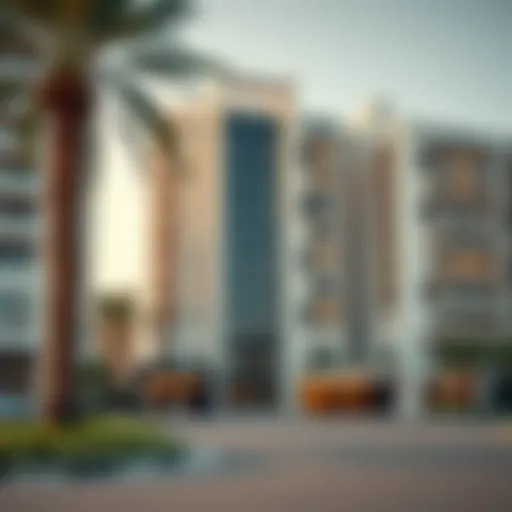Exploring Wooden Parquet Flooring: A Comprehensive Guide
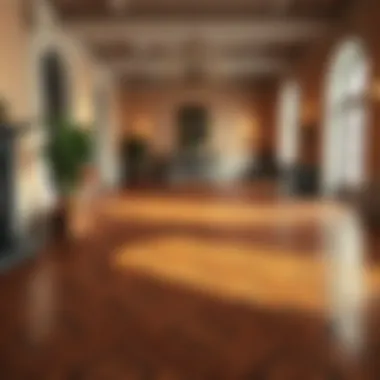
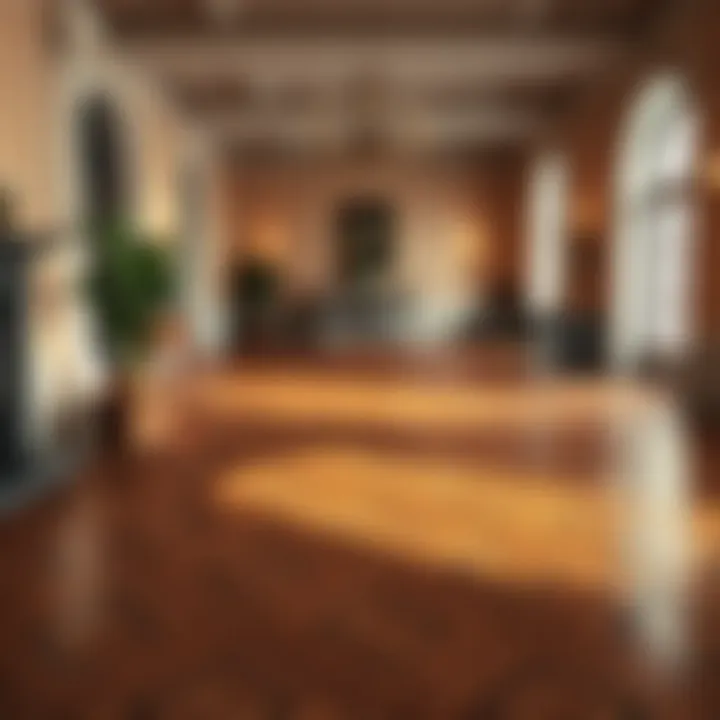
Intro
Wooden parquet flooring has carved its niche as a timeless choice for enhancing the aesthetic appeal of homes and commercial spaces alike. Its intricate patterns and robust nature offer not just beauty but also durability, ensuring that it remains a popular flooring option across various markets. In particular, the Dubai real estate landscape presents a fertile ground for parquet flooring, making it a focal point for homeowners, investors, and realtors.
This guide will unravel the complexities of wooden parquet flooring, touching upon its historical significance, benefits, various types, and maintenance insights. More importantly, it will cater to those looking to invest in properties where parquet flooring could play a crucial role in both appearance and valuation, especially in the thriving Dubai market.
As we dive deeper, you’ll gain practical insights on installation procedures and maintenance tips. Understanding these elements will enable you to elevate your property’s appeal while making well-informed decisions that resonate with modern design trends.
In the following sections, we will explore market insights and investment strategies specific to Dubai, noting how these aspects intersect with the implementation of wooden parquet flooring.
The Historical Context of Wooden Parquet Flooring
Understanding the historical context of wooden parquet flooring provides invaluable insights into its evolution and significance in various cultures. This segment sets the stage for exploring not just the aesthetic charm of parquet but also its cultural depth and the craftsmanship that went into its creation. The beauty of parquet flooring goes well beyond its surface appeal, resonating deeply with history, artistry, and tradition.
Origin and Evolution
The origin of wooden parquet flooring can be traced back to the late 16th century in France. Initially, it was perceived as a practical solution to the issues posed by the cold and damp stone floors of many residences. This innovation saw wooden blocks arranged in geometric patterns, giving birth to a style that was both functional and visually appealing. Over the years, European countries embraced this flooring style, adapting it based on their unique architectural styles and preferences.
The craftsmanship involved in parquet flooring reflects an artisanal heritage. Craftsmen would often handcraft each piece, ensuring that the quality of the wood and the precision of the cuts were of the highest standards. As different wood species were utilized, the patterns varied, leading to a wide array of designs and styles.
Fast forward to today, and while techniques have modernized and manufacturing processes have evolved, the intrinsic beauty and value of parquet flooring have remained steadfast. Many contemporary designs are reminiscent of these historical patterns while incorporating modern technology, creating a harmonious blend of past and present.
Cultural Significance Across Eras
Parquet flooring has left its mark across various cultures throughout history. In France, parquet became synonymous with luxury and sophistication, often seen in the grand salons of châteaux. This flooring choice was more than just aesthetic; it represented status and a certain lifestyle.
In the Italian Renaissance, the use of geometric patterns in flooring showcased the era's artistic values. Wealthy families would commission intricate designs to illustrate their wealth and taste. Similarly, in Eastern Europe, parquet took on unique national characteristics, reflecting local craftsmanship and cultural identity.
Modern times have seen a renewed interest in parquet flooring, partially inspired by nostalgia and the desire for authenticity in design. The ongoing appreciation for historical designs is evident in numerous contemporary spaces that seek to incorporate elements of the past into modern aesthetics.
"In every plank and grain lies a story; parquet is not just a floor, it's a timeline of culture and craft."
Thus, the historical dimension of wooden parquet flooring enriches our understanding of not only architectural evolution but also the interplay of culture, art, and functionality throughout centuries. Those looking to invest in or enhance their environments with parquet flooring should appreciate its rich heritage as much as its current trends.
Understanding Wooden Parquet Flooring
When it comes to flooring options, wooden parquet flooring stands as a distinguished choice that resonates with both elegance and practicality. Understanding the ins and outs of this flooring type is pivotal for homeowners, real estate investors, and anyone looking to elevate their living or working spaces. Parquet flooring is not just about aesthetics; it encompasses a multitude of aspects that make it an appealing option. By diving deep into its definition, characteristics, and material varieties, we can appreciate its value more comprehensively.
Definition and Characteristics
Wooden parquet flooring consists of geometric pieces of wood arranged in a pattern to create a unified design. This arrangement can be as simple as herringbone or as complex as a basket weave. One of the defining characteristics of parquet flooring is its versatility mated to its robust structure. It can readily adapt to both classic and contemporary designs, making it a favorite among architects and interior designers. Additionally, parquet floors boast a certain warmth and texture that enhances the ambiance of a space. Its ability to withstand wear and tear adds to its charm, making it a worthy contender in the long-term flooring market.
Another key point to note is the variety of finishes available. Whether one opts for a high-gloss finish to reflect light or a matte finish for a subdued look, the options are plentiful. This adaptability ensures that buyers can tailor their choice to match personal styles and needs.
Material Varieties
When it comes to wooden parquet flooring, the choice of materials significantly impacts quality and longevity. Below, we delve into the specific types of wood used, examining solid wood, engineered wood, and reclaimed wood.
Solid Wood
Solid wood parquet flooring is crafted entirely from natural wood. Its hallmark characteristic is durability. This material offers timeless appeal and can be sanded and refinished multiple times over its lifespan. Homeowners often celebrate solid wood for its natural variations in grain and color. This adds a unique touch to every home, creating a bespoke atmosphere. However, it's important to consider that solid wood can be sensitive to humidity and temperature changes, which might lead to expansion or contraction over time.
"Investing in solid wood is like putting money in the bank—it pays off in the long run."
Engineered Wood
In contrast, engineered wood consists of several layers of plywood topped with a hardwood veneer. This construction offers superior stability compared to solid wood. One key advantage of engineered wood is its resistance to warping, making it ideal for areas with fluctuating humidity levels. Homeowners and investors appreciate this fantastic trait, especially in places like Dubai where temperature can vary greatly. Furthermore, engineered parquet can be a more cost-effective option while still delivering a luxurious look.
Reclaimed Wood
Reclaimed wood is a sustainable choice that often tells a story of its past. Sourced from old buildings, barns, and other structures, this type of wood presents a rustic aesthetic enriched with character. Choosing reclaimed wood not only benefits the environment but also gives buildings a unique charm that new wood simply can't replicate. However, it's worth noting that reclaimed wood may require more maintenance, as it can be less uniform than its newer counterparts. This unevenness is a double-edged sword; while it offers authenticity, some might view it as an inconsistency.
In summary, understanding the types of wooden parquet flooring can make an informed decision easier, leading to fulfillment in choice and satisfaction in investment. It's about blending practicality with personal preference—ultimately enhancing the essence of your space.
Benefits of Wooden Parquet Flooring
The charisma of wooden parquet flooring extends beyond mere aesthetics. For those looking to enhance their spaces, understanding the benefits derived from this distinctive flooring choice is crucial. It’s not just about looks; this flooring style embodies a fusion of practicality and elegance. Let’s break down the key advantages of embracing wooden parquet in your home or commercial property.
Aesthetic Appeal
When it comes to beauty, wooden parquet flooring may well be the cream of the crop. With its intricate patterns and textures, it has the power to transform any space into a work of art. Imagine walking into a room where sunlight dances off the polished surface, revealing every curve and grain of the wood.
Here are a few points to consider regarding the aesthetic appeal:
- Variety of Designs: Parquet flooring can be laid in numerous patterns, such as herringbone or chevron, allowing for personalization that often reflects the buyer’s unique taste.
- Color Range: Available in multiple wood species, such as oak, walnut, and cherry, these options allow homeowners to choose shades that best match their decor.
- Visual Warmth: The natural warmth of wood invokes a sense of comfort, making spaces feel more inviting and homey.
Parquet offers a beauty that resonates with both modern and traditional aesthetics, allowing it to fit into any design concept.
Durability and Longevity
Wooden parquet flooring is not just a pretty face; it has the guts to back it up. Unlike ordinary flooring options, it is built to withstand the test of time. With proper care, well-constructed parquet floors can last decades, making them a smart investment for any property.
Key aspects include:
- Resistance to Wear: High-quality parquet can endure heavy foot traffic without showing signs of wear and tear. This makes it suitable for high-traffic areas in both residential and commercial spaces.
- Refinishing Options: When the finish begins to dull, it can be sanded down and refinished to restore its glory, eliminating the need for complete replacement.
- Stable Performance: Unlike some other flooring types, engineered wood options resist warping and buckling, offering reliability across varying climates.
This durability means that owners can enjoy their flooring without the constant worry of it needing replacement any time soon.
Acoustic Properties
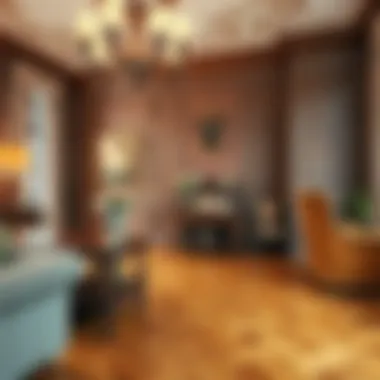
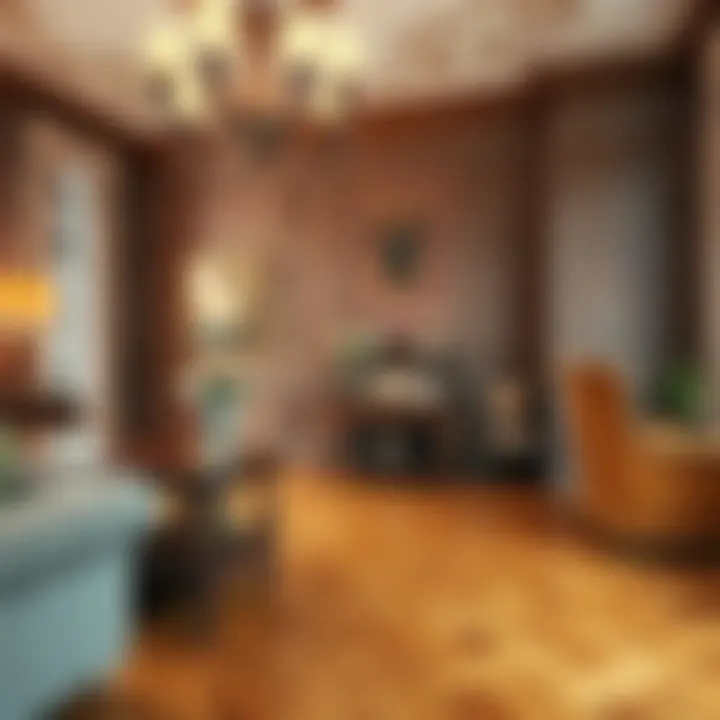
In addition to aesthetic and longevity benefits, parquet flooring also provides remarkable acoustic qualities. The dense structure of wood absorbs sound, significantly contributing to a quieter environment. This aspect is especially relevant in urban settings or busy households.
Benefits of its acoustic performance include:
- Noise Reduction: Parquet floors can minimize the impact of footsteps, allowing for a more tranquil living or working environment.
- Hollow Sound Elimination: Unlike tile or laminate flooring, parquet helps in reducing the hollow sounds that can occur in rooms, creating a more refined experience.
- Enhanced Privacy: In a commercial setting, it aids in reducing sound transmission between spaces, ensuring that conversations remain private and not disturbing to others.
Overall, the acoustic benefits are just another layer to the multi-faceted advantages of parquet flooring, making it a worthwhile consideration for any property owner.
"Choosing parquet flooring is like opting for timeless art; it brings character both in design and functionality."
Installation Methods for Wooden Parquet Flooring
Choosing the right installation method for wooden parquet flooring is a key step that can affect both the aesthetic and functional qualities of the floor. With several options available, homeowners and investors must consider not just the immediate benefits but also long-term implications such as durability, ease of maintenance, and overall installation costs. Understanding these methods is essential for making informed decisions that enhance the value and appearance of a space.
Glue-Down Installation
Glue-down installation is a popular choice for parquet flooring, especially in areas where you want a flat, seamless finish. This method involves applying adhesive directly to the subfloor, then laying down the parquet tiles. There are a few advantages to this method:
- Stability: Glue-down creates a very stable floor that is less likely to expand or contract with changes in temperature and humidity.
- Low Profile: A glue-down installation typically leads to a thinner profile, which can be important in renovations where you want to maintain existing floor heights.
- Versatility: It's suitable for various types of subfloors, be it concrete or plywood.
However, it is important to note that this method requires careful application of adhesive and must be performed in a well-ventilated area. Improper installation can lead to complications later on, such as bubbling or detaching.
Nail-Down Installation
The nail-down method is another traditional approach that involves nailing the parquet strips directly to the wooden subfloor. This technique is often favored for its durability and classic finish. Here are some key aspects:
- Durability: Tightly secured planks reduce the likelihood of movement, making this method particularly robust against wear and tear.
- Sound Absorption: Because of the materials involved, nail-down floors often have good noise reduction properties, which is a desirable feature in residential settings.
- Aesthetic Appeal: The nailing technique allows for slight variances between planks, giving a more natural wood finish that many homeowners appreciate.
While it can be a bit more labor-intensive compared to glue-down installations, the longevity and robustness often justify the effort. Additionally, having some experience with home improvement can make this method accessible for DIY enthusiasts.
Floating Installation
Floating installation allows you to install parquet flooring without the need for nails or glue. Instead, the planks are designed to interlock, providing a structure that floats over the existing subfloor. This method comes with its own set of benefits:
- Ease of Installation: Floating floors can be installed quickly, making them a popular choice for those looking to save time.
- Flexibility: This method allows for some natural movement, making it less susceptible to buckling.
- Minimal Preparation: It requires little to no preparation of the subfloor, which can be advantageous for those dealing with imperfections in the underlying surface.
However, floating installations might not be suitable for all types of parquet. Using too thin or lightweight materials can compromise stability. It is essential to choose high-quality products to ensure long-lasting results.
Maintenance Practices for Parquet Flooring
Maintaining wooden parquet flooring is essential to ensure its longevity and visual appeal. These intricate patterns not only enhance the beauty of any space but also require proper care to retain their charm. Practicing regular maintenance helps prevent severe damage and can save you money in the long run.
Routine Cleaning
Keeping parquet floors clean doesn’t have to be a monumental task. On a day-to-day basis, sweeping or using a dust mop can effectively remove dirt and debris, which might otherwise scratch the surface. Occasionally, a damp mop with a wood-friendly cleaner can do wonders in bringing back the shine.
It’s crucial to avoid excessive water usage, as prolonged moisture can warp the wood or damage the adhesive used in some installation methods. Hence, the golden rule: Always wring out the mop thoroughly! If you have pets or kids running around, a more frequent cleaning schedule might be necessary. Stay vigilant; even the tiniest of crumbs can become foes for your lovely floor.
Periodic Maintenance
Refinishing
Refinishing involves sanding down the surface of the parquet to reveal fresh wood and apply a new finish. This practice is pivotal as it not only restores the aesthetic appeal but also adds a layer of protection against everyday wear and tear.
Many opt for this choice as it can breathe new life into aging floors without needing a full replacement, which is both costly and time-consuming. A well-refinished floor can gleam like brand new, creating a striking contrast against the decor of a space.
However, keep in mind that it is a meticulous process. Too much sanding can lead to unwanted imperfections, and if not done correctly, it could reduce the durability of the floor. It’s prudent to consult professionals for this task if you’re not confident in your abilities to ensure the best results.
Sealing
Sealing is another vital aspect of maintaining parquet flooring. This process involves applying a protective coating that guards against moisture and stains. A good sealant not only adds an additional layer of defense but can also enhance the wood's natural beauty, bringing out the grain and coloration.
By sealing your floors, you effectively prolong the time between refinishings, making it a worthwhile investment. However, keep in mind that once applied, sealants can change the texture and feel of your floor. Moreover, you need to reapply periodically as part of regular maintenance.
Dealing with Damage
Despite all precautions, unforeseen accidents can happen. Scratches, dents, or water marks can threaten even the sturdiest of parquet floors. First, assess the type of damage. For light scratches, a simple wood polish might be enough to disguise the blemish. For deeper cuts or dents, a filler matched to your flooring color can work wonders.
In cases of significant water damage, you might end up needing to replace individual panels. This highlights the necessity of being proactive rather than reactive when it comes to your parquet flooring. Keeping up with maintenance not only saves you headache but also maintains your property’s value.
Design Trends in Wooden Parquet Flooring
As the aesthetic of homes evolves, design trends in wooden parquet flooring take center stage, offering a fresh perspective on how we perceive and utilize this age-old material. In today's evolving architectural landscape, these trends are not just about appearances; they significantly impact market value, functionality, and overall vibe of spaces. Embracing current design trends means aligning with consumer preferences and staying relevant in an ever-competitive real estate environment, particularly in fast-paced markets like Dubai.
Contemporary Patterns
When talking about contemporary parquet patterns, it’s easy to see how they modernize spaces while respecting traditional craftsmanship. Innovative arrangements, such as herringbone and chevron, add visual interest and complexity. When you lay the wood in a zigzag pattern, for instance, it can lead the eye down a hallway, making it feel longer and more opulent.
- Zigzag and herringbone patterns often play with scale, so they might suit smaller rooms just as well as grand entryways.
- Basketweave designs, where squares of wood are woven together, can showcase multiple species of wood, adding depth and a unique character.
- Asymmetrical patterns offer a more progressive approach, enabling aesthetic experimentation and personal expression.
These patterns do more than just look good; they can also disguise imperfections in the flooring beneath. If the floor isn’t perfectly level, a well-planned pattern can help in smoothening that out visually, adding to the overall experience of the space.
Color Variations
The color of parquet flooring plays a crucial role in shaping the atmosphere of a room. Warm tones tend to create a cozy and inviting setting, while cooler tones often exude a sense of modernity and sophistication. Recent trends lean heavily towards rich, deep stains that enhance the natural grain of the wood—think deep mahogany or smokey walnut. This country could be a flavor of elegance.
- Light-colored woods, such as beech and oak, have become increasingly popular as they provide brightness to the space and complement contemporary minimalist designs.
- Weathered shades, characterized by greyed or washed-out hues, allow homeowners the rustic appeal while simultaneously keeping the overall look polished.
- Custom finishes are increasingly sought after, where individual homeowners opt for bespoke colors tailored to their specific decor, creating a truly unique look.
These variations cater to a range of personal styles, making parquet a highly adaptable choice.
Incorporating Parquet in Modern Interiors
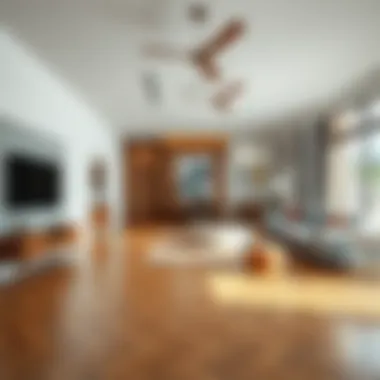
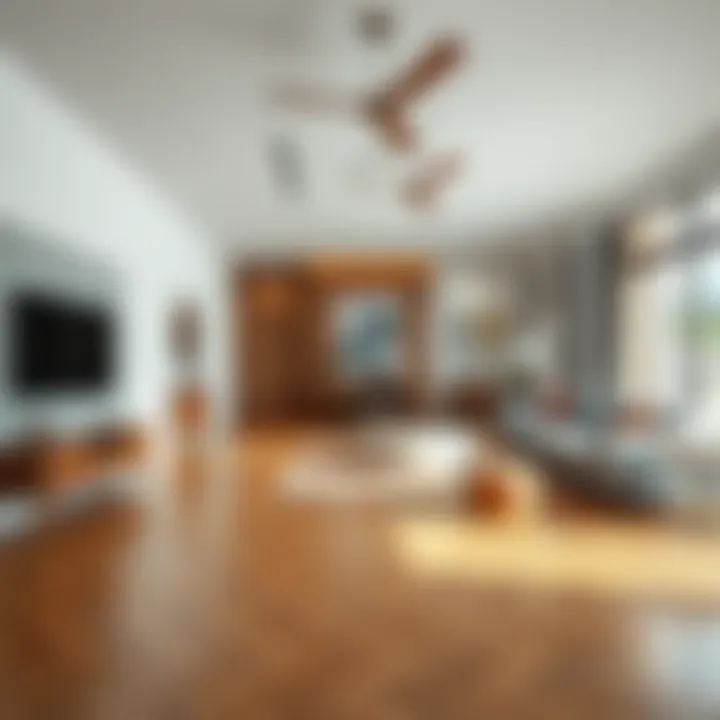
Incorporating parquet flooring into contemporary spaces requires a delicate balance between modernity and tradition. It's an act of merging styles; for instance, pairing sleek, minimalist furniture with intricate parquet can create a striking contrast. The finesse of parquet doesn’t have to be limited to flooring alone—many interior designers are now integrating parquet patterns into wall treatments and cabinetry as well, further amplifying their dramatic appeal.
- Open-concept designs thrive with parquet flooring, creating continuity across spaces and inviting visual interactions among different areas of a home.
- In high-ceiling loft apartments, laying wide planks in an intricate pattern can emphasize verticality and grandeur, while smaller spaces can benefit from tighter patterns to maintain an airy feel.
"A well-chosen parquet floor has the power to transform not just the aesthetics of a room, but also the entire living experience."
Cost Considerations for Wooden Parquet Flooring
When contemplating the installation of wooden parquet flooring, understanding the financial implications becomes crucial. This section elucidates the various cost factors associated with parquet flooring, shedding light on the initial investments and the long-term value they offer to different stakeholders, such as homeowners, realtors, and investors.
Initial Investment
The initial investment in parquet flooring can be a bit daunting, yet it’s essential to gauge it accurately. This cost isn’t just about the price of the wood itself; there are several elements at play:
- Materials: Depending on whether you choose solid wood or engineered options, the prices can swing significantly. For example, high-quality oak might set you back more than a less common species like bamboo or beech.
- Labor Costs: Installation can be labor-intensive, especially if you opt for intricate patterns. Hiring professional installators can push the budget northwards but is often worth it for savings on future repairs or floor issues.
- Preparation and Underlayment: The state of the subfloor and the need for underlayment can add additional costs. If the subfloor isn’t level or is damaged, you might have to invest in repairs or additional materials.
For a clearer picture, here’s a rough estimate:
- Solid Wood Parquet: $8 to $20 per square foot, including installation.
- Engineered Wood: $4 to $15 per square foot, on average.
Evaluating your space, aesthetic desires, and budget can help streamline your choices here.
Long-Term Value
While the upfront costs of parquet flooring can be steep, the long-term value cannot be overlooked. For those looking at it from an investment standpoint, it’s often said:
"Quality never goes out of style."
- Durability: Wood, especially when treated properly, can last for decades. This durability makes it a smart choice for high-traffic areas in both homes and commercial spaces.
- Resale Value: Homes with elegant parquet flooring tend to appeal more to potential buyers. In real estate, aesthetics matter significantly, and high-quality flooring can enhance property value, particularly in markets like Dubai’s.
- Low Maintenance: Parquet floors require minimal maintenance compared to other flooring types. Regular cleaning can prevent excessive wear. Investing in quality upfront may mean less need for replacements or extensive repairs later on.
- Timeless Appeal: The classic look of wood flooring suits various design aesthetics, from traditional to contemporary. Thus, it remains attractive regardless of changing design trends.
Sustainability of Wooden Parquet Flooring
Sustainability has become an essential topic of consideration in today’s world as concerns about the environment continue to grow. In the context of wooden parquet flooring, this importance translates to several critical elements that can positively impact both consumers and the planet. When discussing sustainability, it is imperative to examine the materials used, the manufacturing practices involved, and the overall life cycle of the flooring itself.
Eco-Friendly Materials
Choosing eco-friendly materials for wooden parquet flooring plays a vital role in enhancing sustainability. Here are some materials that stand out:
- Sustainable Timber: Originating from well-managed forests, certified sources such as those recognized by the Forest Stewardship Council (FSC) ensure that the timber used is harvested sustainably, minimizing the environmental damage.
- Bamboo: Technically a grass, bamboo is famed for its rapid growth cycle and strength, making it an excellent alternative to traditional hardwoods. Its ability to regenerate quickly makes it a sustainable choice.
- Reclaimed Wood: Utilizing wood that has already been harvested from old buildings, furniture, or other sources means that no new trees are cut down. This not only preserves existing forests but also fosters a unique aesthetic due to the character of the aged wood.
When selecting parquet flooring, consider looking for labels or certifications that indicate the sustainability of the materials, as these factors can significantly reduce environmental impact.
Impact on Indoor Air Quality
The materials and processes involved in the production of wooden parquet flooring can influence indoor air quality. It is essential for homeowners and investors to consider how their choices can affect health.
- Low VOC Options: Volatile organic compounds (VOCs) can be emitted from certain finishes and adhesives used in flooring installation. Opting for low-VOC or water-based finishes ensures better indoor air quality by minimizing harmful emissions.
- Natural Materials: Wood itself inherently contributes to better indoor air quality. It helps in regulating humidity by absorbing excess moisture from the air. This feature can lead to a more comfortable living environment.
- Ongoing Maintenance: Keeping parquet floors clean without harsh chemicals is crucial. Regular cleaning with gentle, eco-friendly products not only maintains the wood but also helps to avoid the introduction of harmful substances into the home.
By prioritizing sustainable materials and practices, consumers contribute to a healthier planet for future generations while enjoying the warmth and beauty of wooden parquet flooring.
The layout and choice of parquet flooring can reflect not just personal taste but also a commitment to sustainability. These choices should resonate particularly with investors, realtors, homebuyers, analysts, and renters, as they blend aesthetic appeal and ecological consciousness.
Choosing the Right Parquet Flooring for Your Space
When it comes to choosing parquet flooring, it's not just about picking what looks good. Wooden parquet flooring is an investment, and every detail counts. Factors like room size, foot traffic, and your personal style play a vital role in the decision-making process. This section aims to guide you through understanding and pinpointing your needs to ensure that you select the best parquet flooring that fits seamlessly into your home or property.
Assessing Your Needs
First off, take a good long look at the space where you're planning to lay down that beautiful wooden parquet flooring. Functionality is key. How is that area used? If it’s a bustling family room with kids running about, you’ll want something durable and easy to clean. If it’s a cozy study or a quiet dining room, aesthetics might hold more importance.
Consider the following elements while assessing your needs:
- Foot Traffic: High-traffic areas may require more robust materials such as engineered wood for better wear resistance.
- Room Size and Layout: Larger spaces can handle bold patterns without feeling overwhelming. In contrast, in tighter spaces, smaller designs might create an illusion of depth and flow.
- Color and Finish: Determine what sort of atmosphere you want. Dark woods tend to create warmth, while lighter tones can make the space feel bigger and brighter.
- Comfort and Acoustics: Parquet flooring can influence the sound in a room, so think about how important noise reduction is in that specific area.
Collecting this information may involve a lot of head-scratching, but it’s essential for making an informed choice.
Consulting with Professionals
Nothing beats the wisdom of experience when it comes to flooring. Consulting with flooring experts or interior designers can offer you insights that might not even be on your radar. They can provide a better grasp of practical solutions tailored to your space.
Here’s why this step shouldn’t be overlooked:
- Expert Recommendations: Professionals can guide you toward the types of parquet that will best suit your needs and environments, including maintenance considerations.
- Access to Resources: They often have connections to suppliers and can help you navigate store options much smoother. This could save you time and potentially money.
- Installation Guidance: Knowledge about installation is crucial. An expert can inform you whether it should be a glue-down, nail-down, or floating installation method based on specific details.
- Trends and Styles: Keep up with current trends through someone who has been in the business. They know what is all the rage and what has fallen out of style.
Investing time in assessments and consultations not only paves the way for informed decisions, but it also enhances the overall quality of your finished floor. Remember, well-informed choices lead to lasting satisfaction.
"Choosing the right flooring is not just about aesthetics. It's about enhancing the livability and functionality of your space."
By taking these steps, you pave the way for a beautiful and practical flooring choice that complements your lifestyle and elevates your space.
Parquet Flooring in the Context of Dubai Real Estate
In the bustling real estate scene of Dubai, where luxury meets modern design, each detail counts. Parquet flooring, with its intricate patterns and rich textures, is increasingly becoming a favored option for homeowners and property developers alike. Its ability to provide both elegance and functionality makes it a valuable addition to residential and commercial spaces in the city.
One of the primary reasons for its rise in popularity is the aesthetic appeal. Parquet flooring offers an artistic dimension that plain flooring simply cannot match. The geometric designs can be tailored to fit various styles, from classic to contemporary, unlocking a world of design possibilities. With the right installation, these floors can create a warm and inviting ambiance, setting the tone for luxurious living.
Market Trends and Preferences
Dubai's real estate market has shifted noticeably towards environmentally-conscious and visually dynamic offerings. More buyers are showing a preference for sustainable materials, and wooden parquet fits the bill perfectly. Here are some observed trends within the context of wooden parquet flooring in this region:
- Sustainable Sourcing: As global consciousness about sustainability rises, more buyers in Dubai are considering the environmental impact of their flooring choices. Parquet flooring made from responsibly sourced wood resonates well in this regard.
- Customization Options: Real estate developers are noticing the demand for unique designs. Customized parquet patterns allow for differentiation in competitive neighborhoods.
- Technology Integration: Smart homes are on the rise, and tech-savvy buyers are looking for features that facilitate a modern lifestyle. Parquet floors can incorporate advanced heating systems, enhancing their appeal.
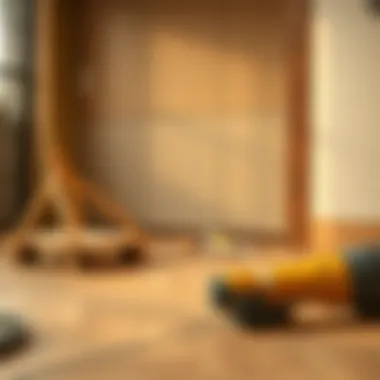
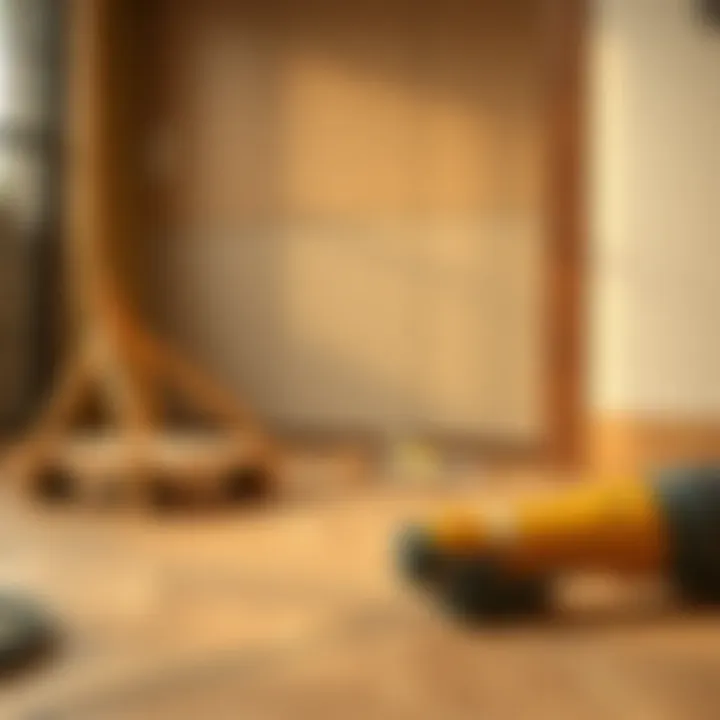
These trends reflect not only a broader movement towards sustainable living but also underscore the growing appreciation for artisanal craftsmanship.
Influence on Property Value
Investors know that the choice of flooring can significantly impact resale value. Wooden parquet flooring can elevate the perception of a property, making it more attractive to potential buyers. This is particularly pertinent in high-demand areas of Dubai, where first impressions matter significantly.
"Investing in high-quality flooring is investing in the future resale value of your property."
Here’s how parquet flooring can influence property value in the Dubai market:
- Luxury Factor: Homes with parquet flooring often command higher prices due to the luxurious vibe they provide. Buyers are willing to pay a premium for aesthetics and quality.
- Durability and Maintenance: Compared to other flooring options, well-maintained parquet floors can last decades. This durability serves as a compelling selling point for prospective buyers, translating to solid return on investment.
- Marketability: Properties featuring stylish and well-preserved parquet flooring tend to stand out in listings. This enhanced marketability can lead to quicker sales at better prices.
Case Studies: Successful Implementation of Parquet Flooring
The real-world application of wooden parquet flooring serves as a testament to its charm and practicality. Including case studies not only illustrates various styles and methods of implementation but also highlights how this flooring option can transform spaces. Real-life examples provide tangible benefits and considerations for potential buyers, investors, and homeowners. Upon analyzing different installations, one can appreciate the adaptability of parquet flooring across a range of environments and design philosophies.
Residential Spaces
In residential settings, parquet flooring breathes life into interiors, merging aesthetic elegance with functionality. Homeowners often choose parquet for its intricate patterns and textures, offering a unique touch that elevates the overall ambiance of a room. Take, for instance, a renovated apartment in a historic district of Paris. Here, the installation of herringbone-patterned oak parquet not only honors the building's heritage but also creates a warm, inviting atmosphere. The flooring choice added considerable character and complemented the vintage furnishings scattered throughout the space.
- Thinking Beyond Looks: One homeowner remarked that the installation contributed significantly to the home’s resale value, transforming an otherwise ordinary space into a desirable attraction.
- Longevity and Maintenance: Another case involved a modern townhouse, where the decision for engineered wood parquet ensured durability against the wear and tear of family life. This homeowner found that the maintenance upkeep was a breeze; simple cleaning routines kept the flooring looking sharp and vibrant.
Commercial Properties
Parquet flooring is also making waves in the commercial sector. Various businesses, including cafes, hotels, and offices, are integrating parquet not just for its aesthetic appeal but also for its ability to withstand heavy foot traffic. A popular café in Dubai, for example, utilized reclaimed wood parquet flooring to craft a rustic yet contemporary vibe, which in turn attracted a steady stream of customers.
- Creating Inviting Spaces: Thanks to its texture and finish, the café successfully enhanced the customer experience, making the space feel cozy and welcoming. This had a direct correlation with increased patronage, leading to higher profits.
- Brand Identity: Additionally, an upscale hotel chain adopted a sophisticated geometric parquet layout in their lobbies. The design not only showcased a commitment to quality but also aligned seamlessly with the luxurious brand identity. It created a pattern that became recognizable among patrons, reinforcing the brand through visual language.
In summary, analyzing case studies of successful parquet flooring implementations sheds light on potential benefits such as enhanced aesthetic appeal and increased value in residential and commercial property alike. Selecting the right design elements allows for creative ventures that can stand the test of time, ensuring satisfaction for both homeowners and business owners.
Technological Innovations in Parquet Flooring
Technological advancements have played a pivotal role in shaping the wooden parquet flooring landscape. With continuous innovations, the industry has seen remarkable improvements in quality, durability, and aesthetic appeal. For investors, homebuyers, and realtors, understanding these advancements is crucial to making informed decisions in today's market. This section dives into some specific elements of these innovations, highlighting their benefits and considerations.
Advanced Manufacturing Techniques
The evolution of manufacturing processes has drastically changed how parquet flooring is produced. Gone are the days when wooden pieces were solely handcrafted. Today, many manufacturers use high-precision machinery to create intricate designs that reflect traditional craftsmanship but at a larger scale.
One significant manufacturing technique is the use of computer numerical control (CNC) machines—these allow for exact cutting of wood pieces, creating complex patterns with minimal waste. Manufacturers can now produce consistent pieces that fit perfectly together, which enhances the final appearance and simplifies the installation process.
Moreover, the introduction of laser technology into the cutting process has allowed for even more details in designs without compromising structural integrity. This means homeowners can have bespoke parquet patterns tailored to their design preferences while maintaining durability.
"The shift to advanced manufacturing has made quality timber flooring accessible to a broader audience, providing both aesthetics and functionality at competitive prices."
In addition to better manufacturing methods, the treatment of the wood has seen substantial changes. Processes such as kiln drying now ensure that wood is more stable, significantly reducing the risks of warping or shrinkage after installation. This stability makes parquet flooring an excellent long-term investment, particularly in variable climates.
Smart Flooring Solutions
In recent years, the integration of smart technology into parquet flooring has gained momentum. Smart flooring solutions enhance not only convenience but also the overall functionality of the floor itself. One of the standout features is the incorporation of sensors that monitor the condition of the flooring and the environment.
For instance, some modern parquet floors come equipped with moisture sensors which can alert homeowners to potential issues before they escalate. By sensing humidity levels, these systems can help in preventing moisture damage, a common concern for wooden flooring.
Another impressive advancement is the ability to integrate smart heating systems directly into the floor. This innovation provides an energy-efficient heating solution, allowing for warm feet on chilly days without the unsightly radiators.
Alongside these practical features, many smart parquet solutions can connect to home automation systems. This means you can adjust your floor's features or even the temperature directly from your smartphone or tablet, adding another layer of convenience to home management.
Closure
The technological innovations in parquet flooring illustrate a commitment to marrying traditional beauty with modern convenience. These advancements not only elevate the aesthetic and functional aspects but also bring significant factors such as longevity and ease of use into the mix. As the market continues to evolve, potential buyers and investors should keep an eye on these innovations to ensure they’re making the best possible choices for their spaces.
Regulations and Standards for Parquet Flooring
Understanding the regulations and standards surrounding wooden parquet flooring is crucial for several reasons. These frameworks not only ensure safety and compliance but also promote quality and longevity of the flooring products. Adhering to these guidelines can elevate the trust of consumers in the industry's integrity, especially for investors, realtors, and homeowners who are making substantial financial commitments.
Regulations and standards encompass a wide array of factors. This includes material sourcing, installation practices, measures against harmful emissions, and safety requirements. Be it a cozy residence or a sprawling commercial property, ensuring compliance with these regulations not only meets legal obligations but safeguards the health and wellbeing of all individuals interacting with the flooring.
National and Local Guidelines
When it comes to parquet flooring, regulations can vary significantly depending on the region. National guidelines typically set the foundational standards that flooring products must meet. This includes requirements for fire safety, slip resistance, and environmental impact. In the United States, for instance, the standards often refer to those established by organizations like the American National Standards Institute (ANSI) and the Forest Stewardship Council (FSC). These organizations emphasize sustainable practices and promote the responsible management of forest resources.
On the other hand, local guidelines can provide more specific requirements that cater to regional needs and conditions. Cities with a high humidity index may enforce different standards than drier locales, focusing more on moisture resistance. It's beneficial for homeowners and investors to familiarise themselves with these stipulations, as local building codes can directly affect renovation plans and resale value. Always check with local authorities or trusted builders to ensure compliance.
Certification Processes
Certification processes play a pivotal role in ensuring that parquet flooring products adhere to established regulations and standards. Various certifications can be obtained, signaling compliance with environmental, safety, and quality benchmarks. These not only enhance a product's credibility but often aid in marketing these materials to discerning clients who value transparency and responsibility.
The Forest Stewardship Council (FSC) certification, for instance, guarantees that the wood used in flooring is sourced sustainably, appealing to eco-conscious buyers. There are also certifications like the Greenguard Gold, which indicates low emissions of volatile organic compounds (VOCs), improving indoor air quality and making a home safer for families.
"In this age of conscious consumerism, compliance with recognized standards can often be the cherry on top when selecting flooring materials. Consumers today are looking for more than aesthetic; they want transparency and quality."
Moreover, it’s important to not just rely on certifications but to dig deeper into the practices behind them. Investigating the manufacturing processes and the chains of custody can provide invaluable insights into the true value of the flooring rolled out in your homes or investments. Without proper certifications, one might end up with subpar products that not only fail to meet expectations but could also pose risks in terms of health and function.
By understanding these regulations and certification processes, investors, realtors, and homeowners can make well-informed decisions that align not just with aesthetic preferences but also with safety and sustainability.
End: The Future of Wooden Parquet Flooring
As we look ahead, the landscape of wooden parquet flooring is poised for significant evolution. The allure of parquet flooring spans eras, and its presence in homes and commercial spaces reflects not just aesthetic appeal but also sustainability and functionality. Understanding the future of this flooring type is crucial for anyone connected to the real estate market, whether you’re an investor, realtor, homebuyer or simply a renter looking for a stylish dwelling.
The incorporation of technology in manufacturing processes will continue to reshape how parquet flooring is produced and installed. Innovations such as digital printing and advanced adhesives can create durable and visually striking designs that were unimaginable just a few decades ago. This not only enhances the creative possibilities but also aids in reducing wastage and optimizing material usage.
Moreover, sustainability is becoming a key factor driving consumer choice. More homeowners are leaning towards eco-friendly materials, such as reclaimed wood or sustainably sourced timber. As awareness of environmental impacts grows, expect to see increased demand for options that promise lower carbon footprints and healthier indoor air quality. Parquet flooring could play a vital role by utilizing woods from responsibly managed forests or through innovative recycling processes that breathe new life into pre-used materials.
"In the world of flooring, wooden parquet may be old-school, but its future looks bright and full of potential."
In addition to sustainability, design trends are morphing to accommodate modern aesthetics while preserving the timeless elegance that parquet is known for. As architects and designers seek to merge contemporary styles with classic elements, expect to see hybrid designs that incorporate varied wood types and finishes in unexpected configurations.
As a versatile choice, parquet flooring can effortlessly adapt to both residential and commercial settings. For instance, high-traffic areas may benefit from engineered wooden parquet, which combines the beauty of hardwood with durability. Meanwhile, luxury homes may opt for bespoke patterns and unique inlays, giving each space a personalized touch.









